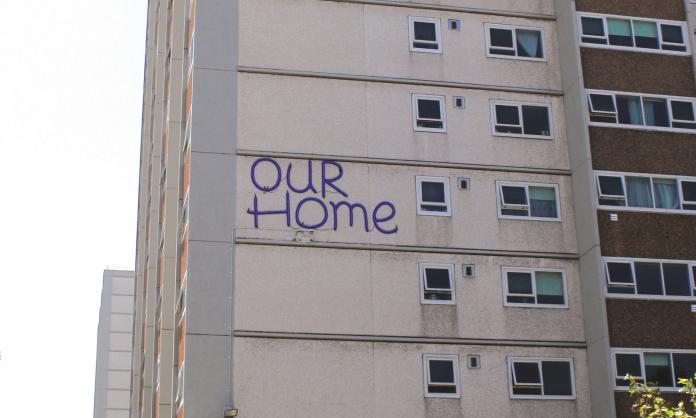The Victorian government’s announcement of a $5.3 billion investment in social housing, which promises 12,000 new dwellings for people on low incomes, has been enthusiastically welcomed by unions and peak social services agencies. Given there are currently more than 100,000 people waiting for housing in Victoria, and it is the state that spends the least per head of population on public housing, it’s not hard to see why any measure purporting to address this crisis might seem like welcome relief.
But the “Big Housing Build” is no such measure. It instead represents a disastrous new milestone in the privatisation of public housing. “The neoliberal moment for housing” that only further entrenches “the government’s exit from public housing” is how RMIT research fellow at the Centre for Urban Research and public housing activist David Kelly described it on a recent Auspol Snackpod podcast. Fiona Ross, a long-time housing activist with Friends of Public Housing Victoria and a public housing tenant, described it in an interview with Red Flag as “the continuation of the policy of privatisation of public housing, now under the banner of the ‘Big Housing Build’”.
The plan is above all a massive handout to the private sector, motivated, it seems, as much by the desire to stimulate the economy and create jobs as it is by the dire need for secure housing. Importantly, it involves no commitment to creating more public housing, and is likely to lead to a net loss.
A breakdown of the spending package by Kelly with fellow Centre for Urban Research academic Libby Porter cuts through the hype. They have found that of the 12,000 promised new units, only about 8,000 will be social housing, with the rest rented at or close to market rates. The term social housing itself is ambiguous—it was introduced by government as an umbrella term to describe both public and community housing, in part to blur the differences between the two. It is widely interpreted by the public as meaning public housing, but almost universally refers to community housing when used by government.
Of the 8,000 social housing units being created, only about 6,000 will be available to the approximately 100,000 people currently on the priority section of the Victorian Housing Register (the housing waiting list). This is because only a small number of the slated new homes will be public housing; almost all the rest will be owned or run by private community housing providers. Unlike government-run housing, community housing providers are not obliged to rent all their stock to those in need. A significant portion may be rented at market rates or very close to them. Of the remainder, only 75 percent have to be made available to those on the Housing Register. This means a significant proportion of the government’s housing budget goes towards subsidising private rentals and the housing costs of others not on the waiting list, rather than being put towards expanding the accommodation available to those most in need.
This is just one of many private sector handouts contained in the Big Housing Build: $2.14 billion of the $5.3 billion package involves, for example, the direct gift of public land to the private sector, including community housing providers, for development. The government hopes this will generate 5,200 new houses, but it is unclear how much of that will be social housing. Even then, any social housing built on this land, will not be public, but will be run by community housing providers.
In the same vein, the “fast start purchase program”, which the government claims will create 2,600 new social houses at a cost of nearly $1 billion, involves subsidising private developers in exchange for the inclusion of some social housing in current or forthcoming developments. This massive handout of public money is entirely avoidable. As housing activists have been arguing for years, the requirement to include minimum levels of social housing in new developments should not be paid for with public money. It should be a legislated obligation, which developers cannot avoid, as it is in many other comparable countries. Had this happened when the Andrews government was first elected, Victoria’s much touted and highly lucrative residential construction boom could have helped provide more units to people who need them, with relatively little outlay of public money. Instead, it has only exacerbated the shortage.
Finally, $1.38 billion of the $5.3 billion package is being allocated as grants to community housing providers to use as they wish, with the government optimistically claiming this will generate 2,200 new social housing dwellings. But there is absolutely no guarantee of this. As Kelly has elsewhere pointed out, a similar grants program initiated in 2017—the Social Housing Growth Fund—promised more than 2,000 houses within five years, yet, so far, none have been built.
Hidden in the detail of the plan is also the destruction of hundreds of existing public housing dwellings. According to Ross, 1,100 public housing dwellings are slated for demolition under the plan. Of those, 436 will be lost as part of the Orwellian-named “renewal” of six public housing estates, a pre-existing privatisation program. They will be replaced by 500 new homes (at a cost of $532 million), leaving a net gain of just 54 houses. And because the 500 new dwellings will be community rather than public housing, the result will be a reduction in the number of genuinely secure homes available to those who need them.
The government’s announcement thus represents a significant milestone in the transition away from government-owned and operated public housing and towards inferior, privately run community housing. “The outcome”, Ross argues, “will be to strip housing stock away from public ownership [and place it] into non-public, commercial ownership. Housing stock owned by the people of Victoria is reduced, while housing stock owned by a tiny elite is massively increased. This is ... being achieved by giving away $5.3 billion of public money”.
Yet the plan has not only escaped criticism from many of those who would ordinarily oppose privatisation; it has been actively celebrated. In large part this reflects the success of the government’s slow-burn, subterranean approach to housing privatisation.
Unlike electricity, public transport or the sale of major public assets like ports, privatisation in the housing sector has been done gradually and largely without raising any alarms. It has involved the gradual transfer of housing stock to private corporations. “Community” housing, as this private form of housing for low income tenants is known, has been expanding rapidly since the early 2000s thanks to this government largesse. In 2008, there were twelve registered community housing agencies managing around 11,000 units. By 2018-19 this had expanded to 39 registered agencies managing 19,694 units. Nationally, the community housing sector operates more than 100,000 properties.
Community housing might sound benign, and the government is keen to play down any difference with public housing, but the reality is it is an inferior form of housing in which tenants have significantly fewer rights.
For one thing, rent is much higher. Public housing tenants pay a fixed 25 percent of their income in rent. If their income is reduced for any reason, so is their rent. Community housing tenants, on the other hand, usually pay 30 percent of their income in rent, and do not necessarily have the right to a reduction in the event of income reduction during their tenancy. On top of this, community housing tenants often also have to pay a service charge that covers basic maintenance and services, most of which are ordinarily covered by rent. If they are eligible for Commonwealth Rent Assistance, this also must all be paid to the community housing provider on top of the rent. Community housing residents can easily end up paying close to half their income to the private housing provider. Public housing tenants also have “a strong framework protecting their human rights”, says Ross. “Community housing does not afford these same protections to tenants ... Feedback from community housing tenants is that company policies are not well explained and can change at any time. Community housing landlords tend to be more punitive than the government. Even with its shortcomings, the state government is a better landlord.”
There is also less of an obligation on community housing providers to take tenants according to need. “Allocation to community housing is not transparent or carefully monitored by an outside independent body to ensure equity of access”, explains Ross. Community housing providers “can cherry-pick prospective tenants and create their own waiting lists from private sources ... [they] are not compelled to house people who are homeless or have been on the waiting list for years”, she says. Those with higher incomes or fewer special needs are more profitable, and therefore more desirable. The government, on the other hand, is obliged to take all its tenants from the Register and then according to urgency of need.
Well-orchestrated government spin has largely disguised this reality. “The privatisation argument continues to be carefully suppressed”, says Ross, “since it is a bipartisan agreement of both Liberal and Labor. Interestingly, when the Liberals were in power, they were more open about calling it privatisation, but Labor wants to avoid the word at all costs ... The media unfortunately has not done in-depth reporting and often confusingly adopts government jargon, which in turn confuses the public. The term ‘not for profit’, for example, belies the fact that the winners of government tenders are huge housing associations, which are certainly profit driven. They plough their surpluses into continuing to further their private empire building”.
At this they have been successful, with the sector’s “earnings” growing at a healthy rate. Total earnings at the end of the 2019-20 financial year were $48 million, with a 4 percent increase in assets to $3.7 billion.
And while not-for-profits may have exclusive access to the sector currently, in Britain a similar government approach that began with transfer of stock to not-for-profits was expanded about two years ago to include for-profit providers. The result, according to housing analyst Rob Beiley, has been “the exponential growth of the for-profit registered provider sector, fuelled by the entry of some of the world’s biggest real estate investors and investment funds into affordable housing”.
Under the Daniel Andrews Labor government, the privatisation of public housing has not only been obscured, but has been actively promoted as a progressive, social democratic reform. One of the largest transfers of public housing stock to the private sector, for example, has been to Aboriginal Housing Victoria, under the banner of Indigenous self-determination. But these transfers have been to the detriment of Indigenous tenants, who have fewer rights and less secure tenancies than they did in government housing.
The upshot is that Victoria has the worst record of any state on the provision of housing, yet is widely lauded as setting a new benchmark for progressive policy and big spending in the area. Only 2.5 percent of total housing stock in Victoria is public housing, the lowest rate of any state and well below the OECD average of 4.6 percent. The amount spent maintaining this stock per head of population is also the lowest in the country, $75 per head compared to $135 in New South Wales and $341 in the Northern Territory.
“Equitable access to clean air, food and water, shelter, education and health care—these are all essential requirements for a democratic and just society”, concludes Ross. “They are far too important to be left to the private sector, which always has the profit motive as its bottom line—it is naive to think otherwise.”
The hotel quarantine fiasco has starkly highlighted the problems with privatisation being second nature for governments no longer accustomed to providing public services and taking responsibility for social problems. This is bad enough. But when privatisation is established as a veritable public good, as it has been in relation to housing, the consequences are disastrous.









